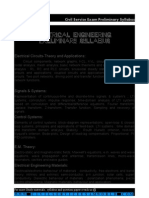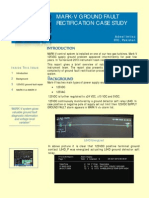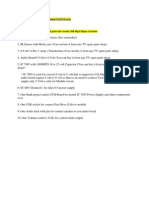0 ratings0% found this document useful (0 votes)
80 viewsSyllabus - Electrical Pune Metro
Syllabus - Electrical Pune Metro
Uploaded by
Prasad WalsingeThe document outlines the syllabus for an online examination for the position of Electrical Engineer for the Pune Metro Rail Project. It covers 9 sections related to electrical engineering topics including electric circuits, electromagnetic fields, signals and systems, electrical machines, power systems, control systems, electrical and electronic measurements, analog and digital electronics, and power electronics. Each section provides a brief overview of the key concepts and topics that will be included in the examination.
Copyright:
© All Rights Reserved
Available Formats
Download as PDF, TXT or read online from Scribd
Syllabus - Electrical Pune Metro
Syllabus - Electrical Pune Metro
Uploaded by
Prasad Walsinge0 ratings0% found this document useful (0 votes)
80 views2 pagesThe document outlines the syllabus for an online examination for the position of Electrical Engineer for the Pune Metro Rail Project. It covers 9 sections related to electrical engineering topics including electric circuits, electromagnetic fields, signals and systems, electrical machines, power systems, control systems, electrical and electronic measurements, analog and digital electronics, and power electronics. Each section provides a brief overview of the key concepts and topics that will be included in the examination.
Original Title
Syllabus_Electrical Pune Metro
Copyright
© © All Rights Reserved
Available Formats
PDF, TXT or read online from Scribd
Share this document
Did you find this document useful?
Is this content inappropriate?
The document outlines the syllabus for an online examination for the position of Electrical Engineer for the Pune Metro Rail Project. It covers 9 sections related to electrical engineering topics including electric circuits, electromagnetic fields, signals and systems, electrical machines, power systems, control systems, electrical and electronic measurements, analog and digital electronics, and power electronics. Each section provides a brief overview of the key concepts and topics that will be included in the examination.
Copyright:
© All Rights Reserved
Available Formats
Download as PDF, TXT or read online from Scribd
Download as pdf or txt
0 ratings0% found this document useful (0 votes)
80 views2 pagesSyllabus - Electrical Pune Metro
Syllabus - Electrical Pune Metro
Uploaded by
Prasad WalsingeThe document outlines the syllabus for an online examination for the position of Electrical Engineer for the Pune Metro Rail Project. It covers 9 sections related to electrical engineering topics including electric circuits, electromagnetic fields, signals and systems, electrical machines, power systems, control systems, electrical and electronic measurements, analog and digital electronics, and power electronics. Each section provides a brief overview of the key concepts and topics that will be included in the examination.
Copyright:
© All Rights Reserved
Available Formats
Download as PDF, TXT or read online from Scribd
Download as pdf or txt
You are on page 1of 2
MAHARASHTRA METRO RAIL CORPORATION LTD
(Pune Metro Rail Project)
Syllabus for online examination(CBT)
Electrical Engineering (For Minimum educational qualification
B.E/B.Tech(Electrical)
Section 1: Electric circuits
Network elements: ideal voltage and current sources, dependent sources, R, L, C, M elements; Network solution
methods: KCL, KVL, Node and Mesh analysis; Network Theorems: Thevenin’s, Norton’s, Superposition and
Maximum Power Transfer theorem; Transient response of dc and ac networks, sinusoidal steady-state analysis,
resonance, two port networks, balanced three phase circuits, star-delta transformation, complex power and power
factor in ac circuits.
Section 2: Electromagnetic Fields
Coulomb's Law, Electric Field Intensity, Electric Flux Density, Gauss's Law, Divergence, Electric field and
potential due to point, line, plane and spherical charge distributions, Effect of dielectric medium, Capacitance of
simple configurations, Biot‐Savart’s law, Ampere’s law, Curl, Faraday’s law, Lorentz force, Inductance,
Magnetomotive force, Reluctance, Magnetic circuits, Self and Mutual inductance of simple configurations.
Section 3: Signals and Systems
Representation of continuous and discrete time signals, shifting and scaling properties, linear time invariant and
causal systems, Fourier series representation of continuous and discrete time periodic signals, sampling theorem,
Applications of Fourier Transform for continuous and discrete time signals, Laplace Transform and Z transform.
Section 4: Electrical Machines
Single phase transformer: equivalent circuit, phasor diagram, open circuit and short circuit tests, regulation and
efficiency; Three-phase transformers: connections, vector groups, parallel operation; Auto-transformer,
Electromechanical energy conversion principles; DC machines: separately excited, series and shunt, motoring and
generating mode of operation and their characteristics, speed control of dc motors; Three-phase induction
machines: principle of operation, types, performance, torque-speed characteristics, no-load and blocked-rotor tests,
equivalent circuit, starting and speed control; Operating principle of single-phase induction motors; Synchronous
machines: cylindrical and salient pole machines, performance and characteristics, regulation and parallel operation
of generators, starting of synchronous motors; Types of losses and efficiency calculations of electric machines
Section 5: Power Systems
Basic concepts of electrical power generation, ac and dc transmission concepts, Models and performance of
transmission lines and cables, Series and shunt compensation, Electric field distribution and insulators, Distribution
systems, Per‐unit quantities, Bus admittance matrix, Gauss- Seidel and Newton-Raphson load flow methods,
Voltage and Frequency control, Power factor correction, Symmetrical components, Symmetrical and
unsymmetrical fault analysis, Principles of over‐current, differential, directional and distance protection; Circuit
breakers, System stability concepts, Equal area criterion, Economic Load Dispatch (with and without considering
transmission losses).
Section 6: Control Systems
Mathematical modeling and representation of systems, Feedback principle, transfer function, Block diagrams and
Signal flow graphs, Transient and Steady‐state analysis of linear time invariant systems, Stability analysis using
Routh-Hurwitz and Nyquist criteria, Bode plots, Root loci, Lag, Lead and Lead‐Lag compensators; P, PI and PID
controllers; State space model, Solution of state equations of LTI systems, R.M.S. value, average value calculation
for any general periodic waveform.
Section 7: Electrical and Electronic Measurements
Bridges and Potentiometers, Measurement of voltage, current, power, energy and power factor; Instrument
transformers, Digital voltmeters and multimeters, Phase, Time and Frequency measurement; Oscilloscopes, Error
analysis.
Section 8: Analog and Digital Electronics
Simple diode circuits: clipping, clamping, rectifiers; Amplifiers: biasing, equivalent circuit and frequency
response; oscillators and feedback amplifiers; operational amplifiers: characteristics and applications; single stage
active filters, Sallen Key, Butterworth, VCOs and timers, combinatorial and sequential logic circuits, multiplexers,
demultiplexers, Schmitt triggers, sample and hold circuits, A/D and D/A converters.
Section 9: Power Electronics
Static V-I characteristics and firing/gating circuits for Thyristor, MOSFET, IGBT; DC to DC conversion: Buck,
Boost and Buck-Boost Converters; Single and three-phase configuration of uncontrolled rectifiers; Voltage and
Current commutated Thyristor based converters; Bidirectional ac to dc voltage source converters; Magnitude and
Phase of line current harmonics for uncontrolled and thyristor based converters; Power factor and Distortion Factor
of ac to dc converters; Single-phase and three-phase voltage and current source inverters, sinusoidal pulse width
modulation.
You might also like
- 2kW Free Energy Device - Don SmithDocument5 pages2kW Free Energy Device - Don SmithJake Mitchell80% (30)
- Syllabus ElectricalDocument2 pagesSyllabus ElectricalRameshwar Kasbe PatilNo ratings yet
- Gate 2021 EE SyllabusDocument2 pagesGate 2021 EE SyllabusAbhishek RajNo ratings yet
- Electrical and Electronics EnggDocument2 pagesElectrical and Electronics EnggKrishna Reddy SvvsNo ratings yet
- En Ee Gate SyllabuDocument3 pagesEn Ee Gate SyllabunavneetNo ratings yet
- Power Electronics and Drives: Semiconductor Power Diodes, Transistors, Thyristors, TriacsDocument2 pagesPower Electronics and Drives: Semiconductor Power Diodes, Transistors, Thyristors, TriacsSunilkumarNo ratings yet
- Gate 2025 Ee SyllabusDocument3 pagesGate 2025 Ee SyllabusUday NanamcharlaNo ratings yet
- Digital Signal Processing by Ramesh BabuDocument1 pageDigital Signal Processing by Ramesh BabuSubhankar DeyNo ratings yet
- Genco Syllabus For EEE BranchDocument2 pagesGenco Syllabus For EEE BranchMansa ManuNo ratings yet
- Indicative SyllabusDocument2 pagesIndicative Syllabusstudyking408No ratings yet
- Section 1: Engineering MathematicsDocument2 pagesSection 1: Engineering MathematicsVishal DibyaNo ratings yet
- Apspdcl Ae SyllabusDocument1 pageApspdcl Ae SyllabusJanjanam PraveenNo ratings yet
- A N Ne X U R E Syllabus (For Electrical Branch/AE) : 1. Electrical Circuits and NetworksDocument1 pageA N Ne X U R E Syllabus (For Electrical Branch/AE) : 1. Electrical Circuits and NetworksshafibhaiNo ratings yet
- Ee 2022Document3 pagesEe 2022Madhumita Sanjay PatilNo ratings yet
- TRB Poly EeeDocument3 pagesTRB Poly EeeCyril PilligrinNo ratings yet
- Apgenco Assistant Engineer (Electrical) Exam Syllabus: 1. Electrical Circuits and NetworksDocument1 pageApgenco Assistant Engineer (Electrical) Exam Syllabus: 1. Electrical Circuits and NetworksCh RajaNo ratings yet
- EE Electrical EngineeringDocument3 pagesEE Electrical EngineeringSunil KumbarNo ratings yet
- ElectricalDocument2 pagesElectricalHkStocks0% (1)
- 1 Syllabus EtoDocument2 pages1 Syllabus EtoVinay PrakashNo ratings yet
- Gate 2018 SyllabusDocument3 pagesGate 2018 Syllabussampurnanand mishraNo ratings yet
- 137APGENCO ASSISTANT ENGINEERS Electical SyllabusDocument2 pages137APGENCO ASSISTANT ENGINEERS Electical SyllabusbadriNo ratings yet
- Syllabus Electrical Engg CseDocument7 pagesSyllabus Electrical Engg CseKrishna Mohan ChauhanNo ratings yet
- Electrical Engineering Syllabus 2 Recruitment of Officers 24-25Document2 pagesElectrical Engineering Syllabus 2 Recruitment of Officers 24-25jobs21195a0208No ratings yet
- SyllabusDocument2 pagesSyllabusbanmallikNo ratings yet
- Section 2: Electromagnetic FieldsDocument1 pageSection 2: Electromagnetic FieldsChirag PandyaNo ratings yet
- GATE Electrical Engineering SyllabusDocument3 pagesGATE Electrical Engineering SyllabusSaisreeNo ratings yet
- Electrical and Electronics EngineeringDocument2 pagesElectrical and Electronics EngineeringRajaShekarNo ratings yet
- GATE Syllabus 2024 Electrical EngineeringDocument7 pagesGATE Syllabus 2024 Electrical EngineeringsvlcseNo ratings yet
- TranscoDocument3 pagesTranscoAnonymous s3bKn2mpDNo ratings yet
- EE SyllabusDocument4 pagesEE Syllabussatish kadalaNo ratings yet
- Electrical Engineering Syllabus 141023Document2 pagesElectrical Engineering Syllabus 141023missiongateair100No ratings yet
- Short Description of SubjectsDocument2 pagesShort Description of SubjectsRamNo ratings yet
- Electric Circuits and Fields:: Single Phase Transformer - Equivalent Circuit, Phasor DiagramDocument1 pageElectric Circuits and Fields:: Single Phase Transformer - Equivalent Circuit, Phasor DiagramGaurav SinghNo ratings yet
- Electrical Engineering Preliminary SyllabusDocument3 pagesElectrical Engineering Preliminary Syllabusசுப.தமிழினியன்100% (2)
- TRB Syllabus For EEEDocument2 pagesTRB Syllabus For EEEdharshanirymondNo ratings yet
- Upsc CSE Ele SyllabusDocument2 pagesUpsc CSE Ele SyllabusgppNo ratings yet
- M.tech Syllabus Jamia University DelhiDocument1 pageM.tech Syllabus Jamia University Delhidheerajdb99No ratings yet
- Aptransco SyllabusDocument2 pagesAptransco SyllabusAnil YvsNo ratings yet
- Electrical Main Syll IasDocument3 pagesElectrical Main Syll IasRNikaNo ratings yet
- Ecil Eee and Eie SyllabusDocument3 pagesEcil Eee and Eie SyllabusSai Krishna LakkavajjalaNo ratings yet
- Paper - I 1. Circuit Theory:: Electrical EngineeringDocument3 pagesPaper - I 1. Circuit Theory:: Electrical EngineeringEr Paramjit SinghNo ratings yet
- Electrical Engineering Syllabus For IESDocument3 pagesElectrical Engineering Syllabus For IESSanjay YadavNo ratings yet
- ETO - Interview SyllabusDocument3 pagesETO - Interview SyllabusKarthikeyan GNo ratings yet
- Electrical SyllabusDocument2 pagesElectrical SyllabusSumit SinghNo ratings yet
- UPSC CSE Electrical Engineering SyllabusDocument2 pagesUPSC CSE Electrical Engineering Syllabusbpsharmab1p1No ratings yet
- Eletrical SyllabusDocument3 pagesEletrical SyllabusRadhey LoyaNo ratings yet
- Electrical Engineering (EE) : APPGECET-2015Document2 pagesElectrical Engineering (EE) : APPGECET-2015anisetti harishNo ratings yet
- Electrical Engineering Syllabus For UPSC Main ExaminationDocument3 pagesElectrical Engineering Syllabus For UPSC Main ExaminationsujaraghupsNo ratings yet
- For Students With EEE/Instrumentation BackgroundDocument3 pagesFor Students With EEE/Instrumentation BackgroundSankar SaroNo ratings yet
- UPSC Syllabus Electrical EngineeringDocument3 pagesUPSC Syllabus Electrical EngineeringMOHD ALI SHAMSINo ratings yet
- Syllabus of Electrical Engineering PrelimsDocument3 pagesSyllabus of Electrical Engineering Prelimsapi-3710029No ratings yet
- Electrical Engineering (EE) - NDocument2 pagesElectrical Engineering (EE) - NSaicharan NagunooriNo ratings yet
- Day 1 - Syllabus EeDocument2 pagesDay 1 - Syllabus EeRavinder RangaNo ratings yet
- Junior Engineer Electrical SyllabusDocument2 pagesJunior Engineer Electrical Syllabusgyana netraNo ratings yet
- ETO Entrance Test - SyllabusDocument3 pagesETO Entrance Test - SyllabusabhilashNo ratings yet
- Ne01 Scto Electrical / Electronics & TelecommunicationDocument4 pagesNe01 Scto Electrical / Electronics & TelecommunicationvivekNo ratings yet
- Gate 2010 Electrical SyllabusDocument3 pagesGate 2010 Electrical SyllabussatyahbhatNo ratings yet
- GATE Electrical EngineeringDocument2 pagesGATE Electrical EngineeringshiwapreetheeNo ratings yet
- PSU's Common Syllabus For Electrical Engineering Non-Technical: General StudyDocument2 pagesPSU's Common Syllabus For Electrical Engineering Non-Technical: General StudyJitendra TambeNo ratings yet
- Syllabus For IESDocument3 pagesSyllabus For IESSaranya PrabagaranNo ratings yet
- Handbook of Power Systems Engineering with Power Electronics ApplicationsFrom EverandHandbook of Power Systems Engineering with Power Electronics ApplicationsNo ratings yet
- Diode - WikipediaDocument3 pagesDiode - WikipediaGowtham SpNo ratings yet
- Avr Newage mx321 PDFDocument4 pagesAvr Newage mx321 PDFLiya MahagamaNo ratings yet
- Mark-V Ground Fault RectificationDocument5 pagesMark-V Ground Fault Rectificationali_zshan100% (4)
- Diode Circuits ProblemDocument11 pagesDiode Circuits Problemsamantaramen86No ratings yet
- Wireless Request Management SystemDocument94 pagesWireless Request Management SystemGuru VashistNo ratings yet
- Functions of Excitation Systems (Mr. Ayan Kumar Tudu) - 4 PagesDocument4 pagesFunctions of Excitation Systems (Mr. Ayan Kumar Tudu) - 4 Pages'Rupam MandalNo ratings yet
- Frequency Inverter: User's ManualDocument117 pagesFrequency Inverter: User's ManualCristiano SilvaNo ratings yet
- Power Electronics: Chapter 4: Switch-Mode Dc-Ac InvertersDocument71 pagesPower Electronics: Chapter 4: Switch-Mode Dc-Ac InvertersAjay KumarNo ratings yet
- Caddyt Arc 150i Caddyt Tig 150i Origot Tig 150i: Service ManualDocument66 pagesCaddyt Arc 150i Caddyt Tig 150i Origot Tig 150i: Service Manualr_cristiNo ratings yet
- Final B.Tech - CSE AWS SyllabusDocument89 pagesFinal B.Tech - CSE AWS SyllabusAbhishek RaoNo ratings yet
- TubeDocument3 pagesTubesssadangiNo ratings yet
- Va702-1 SMDocument64 pagesVa702-1 SMVictor Antonio RoldanNo ratings yet
- 2organic Electroluminescent DiodesDocument3 pages2organic Electroluminescent DiodesNicolas BuitragoNo ratings yet
- Catalog Insulation Monitoring VigilhomDocument63 pagesCatalog Insulation Monitoring VigilhomMichael Gay100% (1)
- Usb Mp3 Player Connection DiagramDocument12 pagesUsb Mp3 Player Connection DiagramAnil Kumar100% (1)
- EltekDocument8 pagesEltekMartinKampffNo ratings yet
- HVI Sell Sheet PTS-80Document1 pageHVI Sell Sheet PTS-80seba rojasNo ratings yet
- VST 20 HF 220Document6 pagesVST 20 HF 22018EE25 - G.Sharan KrishnanNo ratings yet
- Automation Solution Guide 2008Document312 pagesAutomation Solution Guide 2008Freddy SuhartonoNo ratings yet
- Lecture 7Document33 pagesLecture 7Mohamad SyazwanNo ratings yet
- Full Wave Rectifier and Bridge Rectifier TheoryDocument17 pagesFull Wave Rectifier and Bridge Rectifier TheoryMrmouzinhoNo ratings yet
- FPRB Installation Training With NotesDocument81 pagesFPRB Installation Training With NotespapisNo ratings yet
- Power Factor Improvement Using Dual Boost Converter: Miss. R. S. More, Prof .D.D.AhireDocument6 pagesPower Factor Improvement Using Dual Boost Converter: Miss. R. S. More, Prof .D.D.Ahiresai charanNo ratings yet
- Stps 30170 CDocument9 pagesStps 30170 CKichin_ANo ratings yet
- Bel Assignment-3 Solution Sem-II 06032016 KarDocument16 pagesBel Assignment-3 Solution Sem-II 06032016 Karaman pandeyNo ratings yet
- Semiconductor.1 ShotDocument253 pagesSemiconductor.1 ShotRohit PandeyNo ratings yet
- Design, Simulate and Implement A 5V DC Power Supply With Filter - Group No 14Document15 pagesDesign, Simulate and Implement A 5V DC Power Supply With Filter - Group No 14HARSHIL HARSHIL GUPTANo ratings yet
- Electrical and Electronic Measurement Technology Lab Student's ManualDocument53 pagesElectrical and Electronic Measurement Technology Lab Student's ManualLê Minh QuânNo ratings yet
- Alternators Letrika Web 1Document28 pagesAlternators Letrika Web 1ahmed nourNo ratings yet

























































































